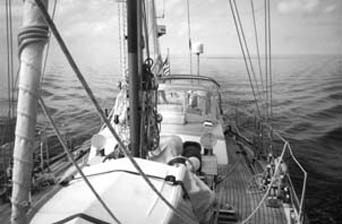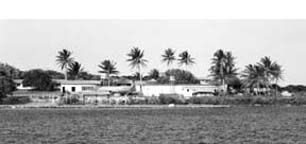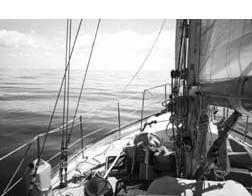The problem was that we arrived at Thursday on Saturday. Thursday was closed on both Saturday and Sunday, and wasn’t open by the time we left on Monday morning. That’s Thursday Island, Australia, just off Cape York, northernmost point on the Australian continent. When it’s closed, it’s really closed.

Arriving on the weekend meant no way to buy fuel. No more fuel meant using our last 70 gallons carefully on the 800-mile trip from Thursday Island to Darwin, Australia. That 70 gallons would be good for at least 450 miles, so we only needed to sail for about 350 miles to be sure of making it. That shouldn’t be a problem in one of the windiest regions of the world, right?
Wrong.
We had already motored or motorsailed about 450 miles on our 1,300-mile trip up inside the Great Barrier reef from Brisbane to Thursday Island. This was very strange. Friends just a few weeks before had roared up the same coast with 25 to 30 knots aft of abeam, and we were motoring in oily calms.
The sea was sometimes so glassy that you could see brilliant yellow sea snakes undulating on the surface 100 yards away. The few dolphins that came to play with us (they are shy of boats under power as the area is heavily fished by prawn trawlers who undoubtedly accidentally net dolphins as well) were clearly visible 50 or more feet under the surface.
Coupled with the bizarre, otherworldly terrain of the northeast coast of Australia, our calm seas produced a feeling of being on another planet. Only frequent encounters with big ships or trawlers in the confined waters inside the Barrier Reef reminded us we were still on planet Earth.
That was more than enough reminder. On this route, you and the ships share the same piece of water, for there is no place else to go. The inside route has choke points a half mile wide, and rarely has more than a few miles of safe water between the coral teeth of the reefs and the shockingly shoal coastal shelf. The ships move north and south at 20 knots with only a few feet of water under their keels. Pilots are required along the entire inside route.
We thought of Captain James Cook, who explored these waters almost 250 years ago in a ship that could barely get out of its own way. What astonishing men these early explorers were! How easy we have it with our weatherly little ship and diesel engine.
Today, this area is overrun with prawn trawlers, beautiful little steel or wood ships from 40 to 65 feet long that stay out for months at a time, selling their catch to motherships.
Their crews work all night and sleep during the day, anchored in any spot out of the shipping channels. These are hard, hard men. They sometimes go mad, killing themselves or each other, unable to deal with the strain of the work, the isolation, the primitive living conditions. It is not a romantic lifestyle.
We combined multi-day trips with long day trips, as sailing in confined waters requires much more alertness than offshore sailing. We anchored in deserted bays with only 12′ of water more than a mile offshore, where the campfires of a few fishermen flickered at night on a shore that as far as we knew was inaccessible except by sea-with no boats in sight.
At sunset one night we were startled to see a large shark swim by a few feet from the boat. Later that night we heard the soft snorting of dugongs. At one point, a large saltwater crocodile drifted past, smiling his evil smile. Sea snakes were everywhere.
These are not waters for swimming.
On another night, we anchored in the mouth of a coastal river, just off a Japanese-owned pearl farm on a small island. There was no sign of human life, except for a shirt fluttering on a clothesline. There was no human life, but two big dogs guarded the dock against intruders. Incongruously, they were a black lab and a big Dalmatian. Where were the pearl farmers? Who fed the dogs, or did they just eat the occasional cruiser who made the mistake of stepping ashore?
We finally decided the human inhabitants had flown from their airstrip to the big town on Thursday Island for a beer, leaving the dogs to hold the fort. Either that, or the farmers, like the fishermen, had gone over the edge and done each other in.
On to Darwin
Our luck and our wind failed just 50 miles out of Thursday Island. We sailed and motored, motored and sailed. Finally we motored, watching our diminishing fuel supply anxiously. We had food, we had water. What we didn’t have was wind.

Our only bail-out option was the bauxite mine at Gove. It was 80 miles out of the way, but they had fuel. With a forecast of no wind, Calypso and our traveling companions aboard the Corbin 39 Obsession headed into Gove for fuel.
At Gove, we stepped into a Crocodile Dundee movie. Everything is covered with thick, red bauxite dust. Cars, buildings, people, are all a uniform ochre in color. It is a company town, built to service the mine. No one would go there for any other reason, although the fishing is said to be good.
We were warned about the large croc in the harbor. We were warned about the large hammerhead shark, too. We were asked not to catch the two big kingfish, which are considered pets. How did the kingfish avoid the croc? Would the hammerhead and the croc fight to the death? These were the questions we pondered over a cold beer at the Gove Yacht Club, itself a scene from Crocodile Dundee. You expected to hear the director call “action.” But there was no action. It was too hot outside, too cold inside.
Less than 24 hours after arriving, we left to cover the remaining 500 miles to Darwin.
We motored and sailed, sailed and motored. We motored some more.
In Darwin at last, more than a month after leaving the winter cold of Brisbane, we sweltered in 95°F heat. During a week there, we pared jobs from our work list, getting ready for the long haul through Southeast Asia and across the Indian Ocean.
Our Indonesian cruising permit arrived in Darwin the same day we arrived. There was nothing holding us back except anxiety.
Actually, we had to leave Darwin fairly quickly. Another round-the-world sailing rally was due in town, and the marina was rented out to them. We also wanted to get to Bali and Singapore before the rally monopolized facilities and services there. These rallies are the bane of the normal cruisers’ existence.
The marina (which is inside a set of locks due to the 25-foot tides) is the only good access to town. The only anchorage involves dragging a dinghy hundreds of yards across mud flats at low water to get to shore. Cyclones regularly devastate the coast, so it makes no sense to build docks that are not protected by locks and dikes. It is not a cruiser-friendly anchorage.

Darwin itself is a frontier town of less than 100,000 people. It is the capital of the Northern Territory, a chunk of Australia bigger than California, Texas, New Mexico, and Arizona combined. The entire territory—including Darwin—has a population of about 160,000 people.
It is not a crowded place.
It has two seasons: the wet, and the dry. It is always hot, as far as we can tell. It is dry now, really dry. And it is really, really hot.
Our faithful Perkins got the luxury treatment in Darwin. Oil and oil filter change. Fuel filters changed. Transmission fluid changed. A new alternator. We are treating it very, very well. Like it or not, the most important piece of gear aboard a cruising sailboat in this part of the world is a reliable engine, for the wind is fickle this time of the year. You also need plenty of clean fuel. We reluctantly now carry five jerry jugs of fuel on deck to supplement the 120 gallons in our tank. This 150 gallons gives us 1,000 miles range under power.
Drifting around at sea for days or weeks is not an option in this part of the world.
On the Road to Bali
In three days, we leave for Indonesia. We are anxious. We have permission to clear into Indonesia at Kupang, West Timor, prior to heading for Komodo. The murder of three UN aid workers there, and the subsequent evacuation of all western aid workers from West Timor, has caused us to change plans. We are now headed straight to Bali.
Somewhere between Darwin and Bali, we cross 10° 40′ south, 118° 22′ east. This is exactly on the other side of the world from Chaguaramas, Trinidad, the easternmost point of our outbound track. We will be halfway round the world. We have sailed 14,500 miles since leaving Newport in November, 1997.
What a long, strange trip it’s been.




































